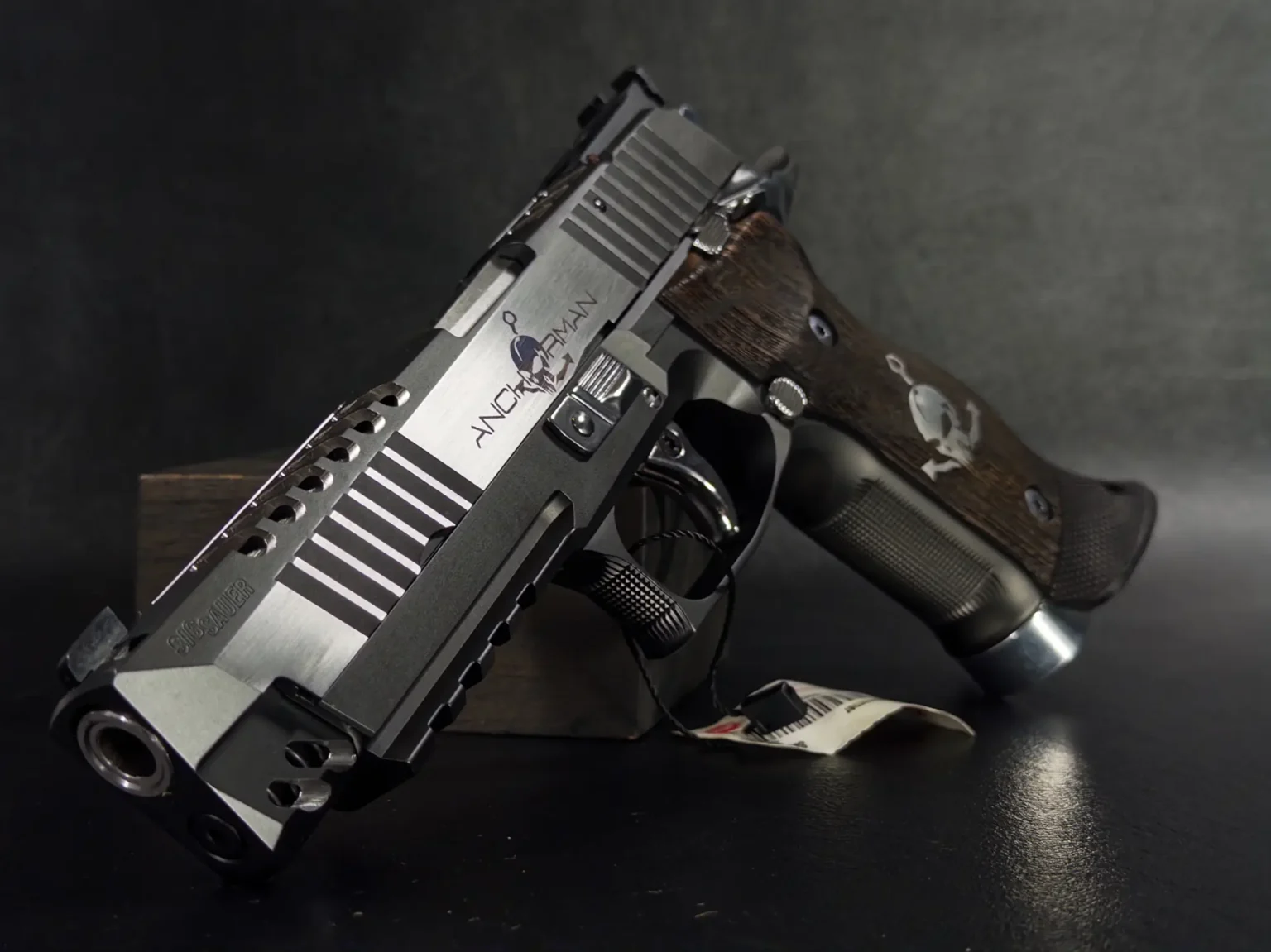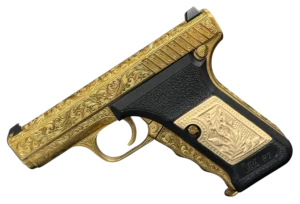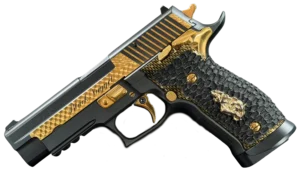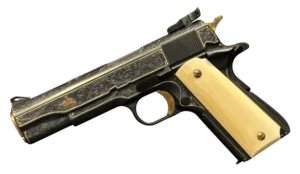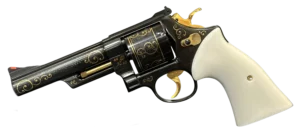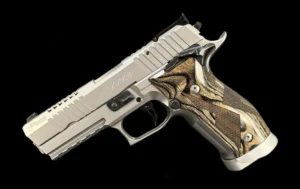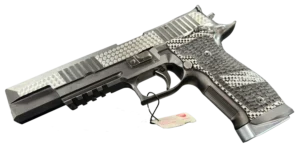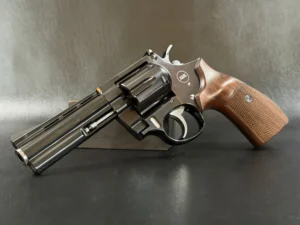Key Takeaways:
- The Anchorman marks the final heartbeat of German SIG craftsmanship: When you hold a P226 Anchorman, you’re not just holding a firearm, you’re holding the closing chapter of the German Mastershop. Built in Eckernförde in the workshop’s twilight years, each Anchorman carries the touch of a craftsman rather than the stamp of a factory. Every polished surface, every tuned trigger, whispers of an era when precision meant patience and pride, not production quotas. In a world now driven by automation, this pistol is proof that the human hand once made steel sing.
- It’s what happens when engineering meets identity: The Anchorman isn’t a marketing edition or a decorative collectible. It’s a conversation between a master shooter, Heribert Bettermann, and the Anchorman Naval Brotherhood, people who cared about discipline, resilience, and the sea. That’s why the pistol feels cohesive: the anchor-and-skull grips, the matte-black PVD finish, even the engraved name all serve a story rather than a style. It’s a firearm that says something about who built it and why, a rare example of engineering that carries a philosophy.
- For collectors, it’s not just rare, it’s irreplaceable: No production figures, no catalogue listing, no second run. The P226 Anchorman exists in a handful of examples that blend sport-pistol performance with cultural symbolism. Its lineage ties together four forces: the legendary P226 platform, the German Mastershop’s precision, Bettermann’s technical mastery, and the Brotherhood’s maritime spirit. That combination will never repeat. For collectors who chase meaning as much as metal, the Anchorman isn’t just another SIG Sauer; it’s the story of the last great collaboration between man, machine, and the sea.
Maritime Spirit in Steel
The SIG Sauer P226 Anchorman is one of those rare pistols that blur the line between engineering and symbolism. Conceived in Germany’s northern ship-town of Eckernförde, it joined the mechanical precision of the P226 X-Series with the ethos of a seafaring brotherhood. The result was two limited-run models, the Anchorman X-Five and Anchorman X-Six, that today stand as quiet monuments to collaboration, craftsmanship, and the final era of SIG Sauer’s German Mastershop.
Origins of the P226 and Its Mechanical Evolution
The Anchorman’s story begins decades earlier, with the development of the P226 itself.
In 1984, SIG Sauer entered the U.S. Army’s XM9 Service Pistol Trials, a program to replace the M1911A1. The company’s submission was the newly designed P226, a double-action/single-action, 9 × 19 mm Luger sidearm built around a sturdy alloy frame and SIG’s modified Browning locking system. Though the Beretta 92F ultimately won the contract for reasons of cost, the P226 was one of only two pistols to pass every phase of the Army’s brutal endurance testing without a malfunction.
That reputation for reliability soon made it a favorite among special operations units. By 1989, the U.S. Navy SEALs had adopted the P226 after experiencing durability issues with their standard pistols. Around the world, law enforcement agencies followed.
From Service Pistol to Competition Instrument
As SIG Sauer refined its designs through the 1990s, the engineers in Eckernförde began pushing the P226 beyond its tactical origins. The outcome was the X-Series: hand-fitted, all-steel pistols built for sport shooting rather than combat. The X-Five (5-inch barrel) and X-Six (6-inch barrel) introduced single-action-only triggers, extended sight radii, and the meticulous slide-to-frame fit that became the signature of the German Mastershop.
Within that creative environment where function and form were treated with equal reverence, the idea of a maritime-themed collaboration took shape.
Heribert Bettermann and the Anchorman Brotherhood
Heribert Bettermann
Few names carry as much weight in Germany’s sport-shooting circles as Heribert Bettermann. A competitive marksman, instructor, and long-time SIG Sauer specialist dealer, Bettermann spent decades tailoring X-Series pistols to the needs of precision shooters. His technical insight and close relationship with the factory made him the natural bridge between SIG’s craftsmen and the shooting community.
The Anchorman Naval Brotherhood
At the same time, in that same coastal town of Eckernförde, another community thrived: the Anchorman Naval Brotherhood (Marinebruderschaft Anchorman e.V.). This international fraternity of mariners and naval officers transcended borders and politics, bound instead by shared experience at sea. Their motto, “Si no est Ego Faciam – Quia non Possum” (“If it doesn’t work, I’ll make it work because I can’t do otherwise”), speaks to independence, endurance, and pride in craft.
When Bettermann met members of the Brotherhood, the connection was immediate. Both parties valued precision, discipline, and tradition. Together, they envisioned a pistol that would capture the Brotherhood’s maritime spirit while maintaining the mechanical integrity of a competition-grade SIG. Thus, around 2019, the P226 Anchorman Project began.
Two variants would emerge:
- P226 Anchorman X-Five, the 5-inch interpretation.
- P226 Anchorman X-Six, its 6-inch long-slide counterpart.
Design and Craftsmanship
At first sight, an Anchorman resting in its case seems to be a dark-finished pistol with polished highlights. However, upon examination, every detail reveals deliberate symbolism.
Construction and Finish
Both models are all-steel, employing SIG’s modified Browning locking system and a single-action-only trigger optimized for competition. The slide wears a matte black PVD coating, broken by brushed-steel flats that catch the light like the hull of a ship. Laser-cut front and rear serrations add practical grip and visual rhythm. On the left side, the word “ANCHORMAN” is boldly engraved as a declaration of identity, rather than a brand.
Polished control surfaces, hammer, trigger, and slide release contrast with the subdued frame, recalling the glint of brass fixtures on a weathered vessel. The slide itself is skeletonized, particularly on the X-Six, its cut-outs giving the gun a distinctly modern, aerodynamic character while trimming reciprocating mass.
Grip Panels
Perhaps the most recognizable feature is the pair of wooden grip panels, stained a deep maritime brown and engraved with the Brotherhood’s emblem, a skull intertwined with an anchor. Buyers could select inlays of brass, sterling silver, or lighter nautical motifs, ensuring individuality within the small run. The grain and texture evoke aged ship planks, linking the pistol’s tactile surface to its maritime inspiration.
Dimensional and Technical Overview
| Model | Caliber | Capacity | Dimensions (L × W × H) | Barrel Length | Sight Radius | Trigger Weight | Weight | Action |
| P226 Anchorman X-Five | 9 mm Luger | 19 + 1 | 223 × 44 × 150 mm | 5 in (127 mm) | 180 mm | ≈ 998 g (2.2 lb) | 1 236 g | Single-action only |
| P226 Anchorman X-Six | 9 mm Luger | 19 + 1 | 240 × 44 × 150 mm | 6 in (152.4 mm) | 206 mm | ≈ 996 g (2.2 lb) | 1 296 g | Single-action only |
Both pistols feature adjustable target sights, the rears finely serrated to cut glare, and maintain the crisp, predictable break typical of high-grade X-Series triggers.
SIG Sauer’s Mastershop: The Final Era
The Anchorman project coincided with the closing chapter of the German SIG Sauer Mastershop, located in Eckernförde.
For decades, this workshop represented the highest expression of the company’s craftsmanship. While mass-production lines supplied duty pistols worldwide, the Mastershop functioned almost like a guild atelier. Small teams of gunsmiths assembled each firearm by hand, test-fired it, and tuned every trigger bar and sear engagement to perfection.
Inside those walls, the X-Series was born, alongside one-off commemorative and engraved masterpieces. The artisans treated machining tolerances as musical notes; each component had to resonate perfectly with the next.
By the late 2010s, however, changes in international regulation and corporate strategy began to affect the German arm of the company. SIG Sauer shifted its focus toward large-scale U.S. production, and the Eckernförde facility gradually wound down operations. When it finally closed, an era came to a close.
The Anchorman X-Five and X-Six, introduced around 2020, belong squarely to this final period. They are among the last pistols to bear the unmistakable feel of hand-fitted German steel products, a hallmark of a workshop culture that valued mastery over efficiency. For collectors, that timing alone elevates their importance: they are the closing signature of a tradition stretching back to the Neuhausen days of Swiss-German precision.
Handling and Aesthetic Character
Though designed as competition arms, the Anchorman pistols project an almost ceremonial dignity. The X-Six, with its six-inch slide and extended sight radius, balances like a precision instrument. The X-Five feels more compact and responsive, ideal for dynamic courses. Both exude solidity; the all-steel frames soak up recoil and provide an immediate sense of control.
The smooth wood of the grips offers comfort rather than aggressive traction, a reminder that these pistols were meant to be handled with respect, not wrestled under duress. The highly polished controls catch light in motion, accentuating the mechanical rhythm of slide, hammer, and trigger.
In use, everything about the Anchorman feels deliberate: the short trigger reset, the weighty slide returning home, the subdued tone of steel cycling on steel. Even to the uninitiated, the impression is unmistakable that this is a pistol built by craftsmen, not machines.
Symbolism and Meaning
The Anchorman’s design language is not arbitrary decoration; it is visual storytelling.
The anchor represents stability, the skull acknowledges the ever-present danger of the sea, and the dark palette suggests endurance against the elements. These motifs align with the Brotherhood’s values of courage, perseverance, and fellowship across borders.
Maritime imagery on firearms is rare, and when it appears, it often risks theatricality. The Anchorman avoids that trap. Its symbolism is integrated rather than applied, woven into the ergonomics and finish. The effect is subtle, more akin to a naval officer’s dress sword than a presentation engraving.
The pistol’s motto, though unstated on the metal, lives in its conception: if something cannot be done, it will be done anyway. In this sense, the Anchorman is a manifesto in steel.
Collectability and Legacy
Because there was never a public production figure, the precise number of Anchorman pistols remains unknown. Contemporary German sources describe them as special versions created through cooperation between Bettermann and the Brotherhood, implying a run measured in dozens, not hundreds.
That scarcity alone places them among the rarer modern SIGs, but their allure goes further. Collectors value the Anchorman for three intertwined reasons:
- Authentic Lineage: Each pistol originates from the German Mastershop, not an aftermarket engraver, ensuring authenticity of materials and assembly.
- Documented Collaboration: The partnership between Bettermann and the Brotherhood is reported in contemporary publications, such as VISIER, providing the series with a traceable provenance.
- Cultural Narrative: The maritime symbolism connects the pistol to an identifiable community and philosophy, transforming mechanical excellence into a cultural expression.
Specification Summary
| Attribute | X-Five | X-Six |
| Caliber | 9 × 19 mm Luger | 9 × 19 mm Luger |
| Capacity | 19 + 1 | 19 + 1 |
| Barrel Length | 127 mm (5 in) | 152.4 mm (6 in) |
| Overall Length | 223 mm | 240 mm |
| Height | 150 mm | 150 mm |
| Width | 44 mm | 44 mm |
| Sight Radius | 180 mm | 206 mm |
| Trigger Weight | ≈ 1 kg (2.2 lb) | ≈ 1 kg (2.2 lb) |
| Unloaded Weight | 1 236 g | 1 296 g |
| Frame Material | All steel | All steel |
| Finish | Matte PVD with brushed steel flats | Matte PVD with brushed steel flats |
| Special Markings | “ANCHORMAN” slide etching; Anchorman Brotherhood logo on grips | Same |
Even within SIG’s long lineage of special editions, the “Blue Moon,” “Jolly Roger,” and others, the Anchorman occupies a distinct niche. It is not a factory-marketed, limited-edition item; it is a bespoke collaboration authenticated by both a renowned shooter and an organized fraternity.
The Collector’s Perspective
In the secondary market, Anchorman pistols surface only occasionally, often retained in private European collections. When they do appear, they command attention not for ornate engraving but for context. They mark the end of the German era and the continuity of SIG Sauer’s identity through individuals rather than corporations.
For curators and historians, they encapsulate the transition between eras from manual artistry to industrial scale. They remind us that behind every serial number once stood a craftsman, and behind every collaboration, a shared vision.
Legacy of the Mastershop and Its Craftsmen
To those who visited the Eckernförde facility, the closure of the Mastershop felt like the lowering of a flag. The men and women who built the X-Series and the Anchorman pistols were part of a lineage stretching back to the post-war revival of German gunmaking.
They worked not with production quotas but with pride. Each pistol’s success was measured not in units shipped but in the feel of the trigger, the smoothness of the slide, and the satisfaction of a client who understood quality.
The Anchorman series, produced at the very end of that tradition, carries the fingerprint of that ethos. When collectors describe these pistols as “the last of the hand-built SIGs,” it is not hyperbole; it is literal truth. After the Mastershop closed, no facility continued that level of bespoke German fitting under the SIG Sauer name.
Thus, the Anchorman pistols are not only commemorative in theme but commemorative in circumstance a final salute from a workshop that defined precision for nearly half a century.
Enduring Meaning
In retrospect, the P226 Anchorman encapsulates a unique convergence:
- The proven engineering of a service pistol refined to sporting excellence.
- The individual vision of Heribert Bettermann;
- The collective spirit of the Anchorman Brotherhood.
- And the twilight craftsmanship of the German Mastershop.
Together, they produced a pistol that is as much an artifact as a firearm. Every cut, every engraving, every polished surface speaks of purpose. It does not seek attention; it commands respect.
For historians of modern arms, the Anchorman demonstrates how collaboration outside corporate boundaries can yield creations of enduring significance. For collectors, it serves as a benchmark, proof that even in the industrial 21st century, handmade excellence remains a valued standard.
Final Reflections
Viewed from a distance, the SIG Sauer P226 Anchorman X-Five and X-Six may appear to be rare sport pistols distinguished by a few cosmetic differences. But to understand them properly is to see the entire narrative etched into their steel.
They represent the lineage of the P226 platform, the artistry of German gunsmiths, the defiant spirit of seafarers, and the human touch of collaboration in an age of automation.
When the lids of their modest SIG cases open, the story becomes tangible: polished steel glints like sunlight on open water, wooden grips are carved like the decks of old ships, and a simple engraving, “ANCHORMAN,” that carries the weight of two worlds.
For those fortunate enough to hold one, the sensation is unmistakable: this is more than a pistol. It is the echo of a workshop, the memory of craftsmen, and a reminder that precision, pride, and purpose can still coexist in a single piece of German steel.
Frequently Asked Questions
It’s a limited-run, German-built variant of the SIG Sauer P226 X-Series, created through a collaboration between competitive shooter Heribert Bettermann and the Anchorman Naval Brotherhood of Eckernförde. Two versions were produced: the X-Five, featuring a 5-inch barrel, and the X-Six, equipped with a 6-inch slide. Mechanically, they’re match-grade single-action pistols; symbolically, they’re tributes to maritime strength and precision engineering.
Yes, but with nuance. The Anchorman pistols were built within SIG’s German Mastershop, using authentic X-Series frames and components, yet they weren’t part of any mass-market catalog. Think of them as factory-authorized collaborations rather than standard production runs: designed, approved, and hand-finished by SIG’s own craftsmen during the workshop’s final years.
Bettermann is a German sport-shooting legend, a marksman, instructor, and long-time SIG Sauer specialist dealer who helped shape the reputation of the X-Series. His decades of tuning and testing SIG pistols made him the natural bridge between the factory and serious competitors. When the Anchorman Brotherhood wanted a pistol that embodied their seafaring motto, “If it doesn’t work, I’ll make it work”, Bettermann knew exactly how to turn that philosophy into metal.
Founded in Eckernförde, it’s an international fraternity of mariners and naval officers who share the traditions of seamanship without political or religious boundaries. Their emblem, a skull entwined with an anchor, symbolizes courage and defiance in the face of the sea’s unpredictability. Those same ideals shape the pistol’s look: dark steel for endurance, polished accents for discipline, and wood grips etched like weathered ship planks.
No official number was ever published. Contemporary German sources describe them simply as special versions created through cooperation with the Brotherhood, which implies a tiny run, likely dozens rather than hundreds. Each example shows minor differences in finish or inlay, reinforcing their semi-custom nature.


